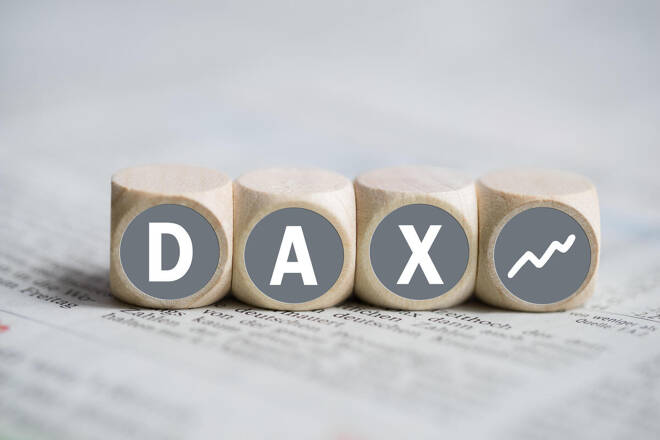Advertisement
Advertisement
DAX Index: Analyzing DAX Stocks in Light of US Treasury Yield Surges
By:
Turbulence in DAX stocks intensifies; central bank dialogues and US indicators steer the course
Highlights
- DAX saw a decline of 1.06% on Tuesday, culminating in a two-day fall.
- Hawkish sentiments rose with US JOLTs pointing towards a possible Fed rate hike.
- Awaiting US ADP nonfarm figures and ISM data, set to dictate DAX’s near-term trajectory.
DAX Tuesday Overview
On Tuesday, the DAX declined by 1.06%. Following a 0.91% loss on Monday, the DAX ended the day at 15,085.
Rate Hike Jitters Sink the DAX
While there were no euro area economic indicators to consider, ECB commentary drew interest.
ECB Chief Economist Philip Lane discussed the ongoing influence of wage growth on inflation. Affirming the higher-for-longer interest rate outlook, Lane reportedly said,
“We do assess that wage inflation will come down, but it’s going to take months, it will take time. So what we saw in September was welcome, but we need to see further progress.
Lane added,
“For services inflation, I welcome September (data), but I think we will be looking at services inflation data for quite a while.”
Later in the session, US JOLTs job openings fueled bets on a hawkish Fed rate path. US Treasury yields surged to a Tuesday high of 4.810%.
The US equity markets tumbled in response to the job openings report and a jump in US Treasury yields. On Tuesday, the NASDAQ Composite Index declined by 1.87%, with the S&P 500 and Dow falling by 1.37% and 1.29%.
The Tuesday Market Movers
Deutsche Bank and Commerzbank continued to see heavy losses, falling 2.66% and 1.96%.
Auto stocks were also among the worst performers. Continental and Volkswagen ended the day down 1.96% and 1.74%. Porsche and Mercedes-Benz Group fell by 1.03% and 1.04%, respectively. BMW declined by 0.90%.
Eurozone Services PMIs in Focus
Euro area service sector PMIs will draw investor interest on Wednesday.
PMI numbers from Italy and Spain will influence market risk sentiment. However, the German and Eurozone PMIs will likely impact the DAX more.
According to prelim figures, the German services PMI increased from 47.3 to 49.8 in September. The Eurozone services PMI rose from 47.9 to 48.4. Subcomponents, including input prices, new orders, and employment need consideration.
Away from the numbers, ECB President Christine Lagarde is on the calendar to speak today. After the comments from Philip Lane, hawkish chatter will likely test buyer appetite for DAX-listed stocks.
ADP Nonfarm and ISM Non-Manufacturing in the Spotlight
Later today, US ADP nonfarm employment change and ISM Non-Manufacturing PMI figures will influence investor sentiment.
Higher-than-forecasted ADP numbers and an unexpected pickup in US service sector activity will likely fuel Fed rate hike jitters.
Economists forecast the ADP to report a 160k increase in employment. However, economists predict the ISM Non-Manufacturing PMI to fall from 54.5 to 53.6.
The DAX and NASDAQ mini were down 72 and 83 points this morning. 10-year US Treasury yields struck a high of 4.852% this morning.
Short-Term Forecast
The futures market and US Treasury yields signal another loss for the DAX on Wednesday. However, the DAX movement will likely hinge on the US economic indicators and central bank commentary. An affirmation of higher-for-longer interest rates from the ECB and Fed will impact buyer appetite for riskier assets.
DAX Technical Indicators
Daily Chart
The DAX sat below the 50-day and 200-day EMAs, reaffirming bearish price signals. A break below the 15,058 support level would bring the 14,814 support level into view.
Upbeat US economic indicators and hawkish ECB and Fed comments will likely bring sub-15,000 into play.
However, a less hawkish ECB President and softer US economic indicators may deliver much-needed support. A return to 15,100 would support a move to the 15,245 resistance level.
The 14-day RSI reading of 31.56 suggests the DAX could fall below the 15,058 support level before it enters oversold territory.
4-Hourly Chart
The DAX, sitting below the 50-day and 200-day EMAs, reaffirms bearish price signals. A DAX return to 15,100 would support a break above the 15,245 resistance level.
However, a drop below the 15,058 support level would bring the 14,814 support level into play.
The 31.29 RSI reading indicates a DAX drop below the 15,058 support level before entering the oversold territory.
For a look at the economic events, check out our economic calendar.
About the Author
Bob Masonauthor
With over 28 years of experience in the financial industry, Bob has worked with various global rating agencies and multinational banks. Currently he is covering currencies, commodities, alternative asset classes and global equities, focusing mostly on European and Asian markets.
Advertisement
